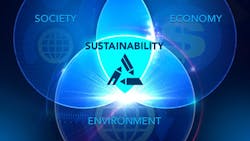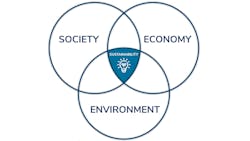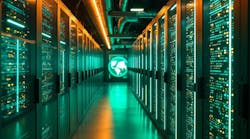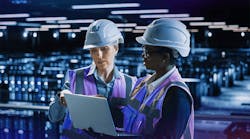Sustainability’s Triple Bottom Line: By Serving Others, We Serve Ourselves
In some ways, sustainability has become a box-checking exercise.
It’s been reduced to measuring carbon footprints and wrapping tight restrictions around operations — a reductive, protective, reactionary practice. However, to realize sustainability’s full potential (meaning, to create the greatest value for stakeholders), organizations must expand their understanding of corporate sustainability’s role in today’s business models.
Corporate sustainability, when it’s at its best, is both protective (it helps us manage compliance, mitigate risk, and create business resilience) and generative (it fuels innovation, maximizes positive impacts, and expands competitive differentiation for lasting growth). Businesses that balance both these perspectives not only safeguard their operations but also position themselves to capture new value and lead in a sustainable economy.
This evolution reflects a broader trend across the data center industry, where sustainability is becoming a central driver of long-term business value and resilience. Still, to establish a corporate sustainability practice that actually generates value, understanding who our true stakeholders are must come first.
Why Should We Care About Sustainability?
The data center industry is facing increased scrutiny around environmental and social impacts. The pressure to work more sustainably comes from all directions: employees, investors, communities, regulators, and customers. This means companies are being more rigorously evaluated on how well they’re addressing questions around climate change, power availability, water scarcity, and community impact as part of their long-term strategy.
Investors, in particular, are looking beyond short-term profitability. They want to know whether a company is positioned to thrive in the long term, which means understanding how it addresses sustainability. On the other end of the spectrum, we’re answering to people outside our industry too — everyday folks who want to better understand how data centers support their online world and function as an additive part of their communities while also preserving resources.
Across the entire ecosystem of customers, investors, communities and beyond, sustainable practices must deliver different types of financial, environmental and social value. Sustainability, then, is not simply about being “green.” It is about recognizing the deep interconnections between financial performance, social responsibility and environmental health.
The purely protective model of corporate sustainability sees the ultimate stakeholder as the business itself: There is one bottom line to protect, and it’s ours. A corporate approach that views sustainability as both generative and protective understands that there are multiple bottom lines we must meet across people, planet and profit — and they’re not exclusive. If we do right by one, value follows across the others.
As economist Herman Daly wrote, “The economy is a wholly owned subsidiary of the environment, not the reverse.” You cannot have a healthy business without a healthy society, and you cannot have a healthy society without a healthy environment. Acknowledging these intersections and understanding a business’s role within them is what corporate sustainability is all about.
Here's how we visualize the intersections across the three pillars of interest — environment, society and economy:
- Environmental-economic: Initiatives such as energy efficiency, renewable energy adoption and green technology reduce operational costs while minimizing environmental impact.
- Social-economic: Ethical labor practices, fair trade and employee benefits contribute to workforce stability, talent attraction and retention and community support, which in turn enhance business performance and support sustainable innovation.
- Social-environmental: Conservation policies, environmental justice and global stewardship promote healthier communities and ecosystems.
At the center of the diagram, where all three pillars overlap, is sustainability. It’s the point where business goals, social responsibility, and environmental stewardship all come together.
A Framework for Shared Value: The Sustainability Continuum
Business and society fundamentally depend on a stable environment. Without access to basic needs such as clean air, water, food and shelter, society cannot thrive, and without a stable society, businesses cannot succeed in the long term.
Take COVID-19 as an example. While some environmental pressures temporarily improved due to reduced activity (less pollution, fewer emissions), the societal and economic impacts were severe. This imbalance demonstrated this interconnection and underscored the need for integrated sustainability strategies that support all three pillars simultaneously.
At Stream, we view sustainability as a continuum that evolves from reactive to proactive, and from risk management to value creation. Companies at the lowest level operate below regulations, exposing themselves to high risk and little value. Most then progress to meeting compliance standards, and many data center companies today go further by adopting eco-efficiencies that cut costs and reduce risks.
However, the greatest impact comes when sustainability is fully integrated into business strategy — woven into decision-making and everyday operations — unlocking innovation, resilience, and long-term growth. While this shift isn’t easy, it offers the most meaningful opportunities.
Adopting an Integrated Model
When sustainability is fully integrated into business strategy, it shifts from a cost-saving initiative to a true competitive advantage. It not only reduces risks but also drives innovation, builds trust with stakeholders, attracts capital and talent, and enables scalable growth — making companies more resilient and better positioned for long-term success.
One of the most powerful outcomes of integration is innovation. When sustainability is embedded into every function, teams are empowered to develop solutions that are both effective and efficient. It makes sustainability scalable. Rather than relying on a single sustainability department, at Stream we’re building a culture where sustainability is part of everyone’s job. This approach empowers every team member to consider sustainability in their decision-making.
How is this applied to day-to-day operations and optimization? At Stream, one example of how this integrated approach has manifested change is our team’s move to replace steel components in new developments with fiberglass reinforced polymer (FRP). This material offers a range of sustainability benefits:
- Environmental: FRP has significantly lower embodied carbon than steel and incorporates
recycled materials. Its lighter weight reduces transportation emissions and infrastructure strain. - Social: FRP is safer and easier to install, requiring fewer specialized workers and heavy
This improves job safety and accessibility. - Economic: FRP offers lower transportation and installation costs, a reduced need for cranes and skilled labor, and high performance at a lower overall price point.
When everyone has skin in the game (as we all do), extrinsic motivation to do better by our investors and customers is rooted in the intrinsic motivation to ultimately do better by our teams and our communities — after all, we live and work in our data center markets. It makes it easy to keep pursuing optimization because we can directly see how more efficient outcomes benefit everyone across the triple bottom line of profit, planet, and people.
Investing in a Sustainable Future
The path to sustainability integration is not without challenges. It requires leadership, commitment and a willingness to rethink traditional business models. But the rewards are significant — enhanced business value, reduced risk, greater innovation and stronger stakeholder relationships. Sustainability considerations are becoming central to how companies set priorities, allocate resources and plan for long-term growth.
At Stream, we’re committed to sustainability across all areas of corporate responsibility. We believe that sustainability is not a separate initiative; it’s a strategic imperative. By integrating sustainability into our business strategy and core operations, we’re building a stronger, more resilient company. Furthermore, by retooling how we think about and implement sustainability, business advantages and social good can easily go hand-in-hand.
About the Author

Amanda Abell
Amanda Abell is Senior Director of Sustainability at Stream Data Centers, which has been delivering mission-critical infrastructure for the world’s most sophisticated companies since 1999. Stream’s portfolio of solutions and commitment to delivering exceptional data center experiences is specifically designed to meet the complex needs of today’s IT infrastructure users.
Since 1999, Stream Data Centers has set new standards for innovation, operational excellence and sustainability in the data center industry. With over 90% of its inventory leased to Fortune 100 customers, the company has acquired, developed and managed complex data center projects for the world’s most demanding users.




